
Eclipse: A Kids’ Guide to Understanding the Exceptional Natural Phenomenon
Our Solar System is in constant movement. Everything in it, as large as the Sun itself or as small as a grain of dust, is rotating on its axis and revolving around a bigger object.
The Moon orbits the Earth. The Earth and the Moon orbit the Sun. The Sun and its entire system as well as more than 3,200 other star systems orbit a supermassive black hole called Sagittarius A*, forming a four-arm, a spiral-shaped galaxy called the Milky Way.
Such movement creates many different events that celestial objects, especially planets, experience. For instance, the rotation of the Earth on its axis creates day and night. Similarly, the four seasons that occur on Earth are caused by its revolution around the Sun.
One of the most exceptional events that many planets including the Earth encounter is an eclipse and this is what we are discussing in this article.
Eclipses
In short, an eclipse happens when an astronomical object passes between the Sun and another object which it orbits, totally or partially blocking the Sun’s light.
Speaking of our Earth and Moon, there are two types of eclipse: the solar eclipse and the lunar eclipse. The solar eclipse happens when the Moon passes between the Sun and the Earth, blocking sunlight and temporarily darkening the Earth.
Likewise, a lunar eclipse occurs when the Earth goes between the Sun and the Moon, obscuring the Sun from the Moon and casting a shadow on it.
That said, we know that the Sun is much, much larger than the Moon. In fact, our burning star is 400 times larger than the Moon. How in the world can the Moon then cover the Sun’s disk if it is that small?
Well, it happens the same way as you can cover the Sun with your palm or even the tip of your index. Objects seem to be similar in size when they are too distant from one another. And with our Moon and Sun, the mere coincidence makes them look the same in size.
As we have just mentioned, the Sun is 400 times bigger in size than the Moon. But the Sun is also about 400 times farther away from the Earth than the Moon. This matching makes both objects look similar in size. Hence, the Moon during a total solar eclipse is able to completely hide the Sun, leaving only a beautiful aura of light around its dark disk.
If the Moon were bigger, it would still be able to cause a total solar eclipse. However, if the Moon were smaller or the Sun were a little closer, total solar eclipses would not be possible.
For a lunar eclipse, the Earth gets in between the Moon and the Sun. If they all line up perfectly, the Earth will block sunlight from the Moon and cast a shadow on it. And because the Earth is a lot bigger than the Moon, its shadow entirely falls on the Moon.
Types of eclipses
Solar eclipses happen in four different types—we will get to discuss them all in more detail later on. There is a total eclipse, partial eclipse, annular eclipse, and hybrid eclipse. A hybrid eclipse is something between a total eclipse and an annular eclipse. Similarly, the lunar eclipse can be total, partial, or penumbral.
The most recent solar eclipse was partial and occurred on April 30th, 2022. People who live in South America were able to view such a partial solar eclipse. The very upcoming solar eclipse, October 25th, 2022, is expected to be partial as well. And if you live anywhere in West Asia, the Middle East, northeast Africa, or Europe, you will be able to witness it.
On the other hand, the last lunar eclipse was total. It took place at night on May 15th, 2022 and ended on May 16th, 2022. It lasted for a total of five hours. The Earth was totally hiding the Sun from the Moon for 85 minutes of that duration, making the Moon turn blood red. Another total lunar eclipse is expected to occur on November 8th, 2022 so mark your calendar.
Having said that, one cannot help but ask a question: do eclipses happen on a regular basis? Or are they coincidental?
Frequency of eclipses
Well, although scientists are able to predict the exact date and time of eclipses for the next thousand years, eclipses are neither coincidental nor regular. To understand how often eclipses happen, we need to look more into how they work. So let’s take a small example to understand the frequency of eclipses.
If you look up to the sky and try to block the Sun with your hand, you have to place it right in front of your eyes, meaning on the same level as your eyes and the Sun. If you place your hand above or below your eyes, the Sun will not be blocked. That is exactly what happens with eclipses.
For a solar eclipse to happen, the Moon has to be on the same level as the Earth. In other words, their orbits have to align at the exact time when the Moon passes between the Earth and the Sun.
This way, the Moon will be able to completely cover the Sun’s disk, casting a shadow on the Earth. Similarly, a lunar eclipse only happens when the Earth goes between the Sun and Moon with all three sharing the same plane.
However, the Moon’s and Earth’s orbits are not on the same level most of the time. The Moon’s orbit is tilted at 5° to the Earth’s orbit. That means the Moon does not orbit the Earth on the same level. But it somehow goes up and down.
So as the Moon orbits the Earth, most of the time it is either to the north or to the south of the Sun’s disk in the sky. As a result, its shadow does not fall on the Earth.
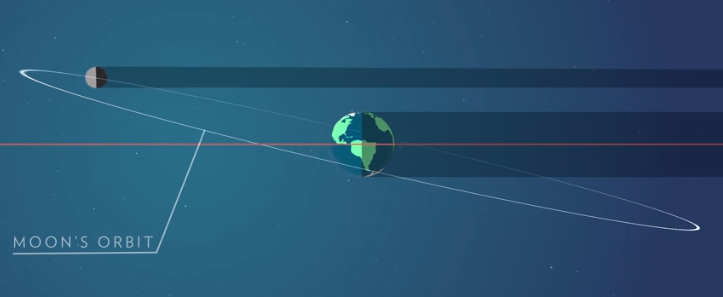
If there were no tilt at all in the Moon’s orbit, if it is aligned perfectly with the Earth’s orbit, we would get a total solar eclipse and a total lunar eclipse every month. But that is unfortunately not possible.
However, we are not completely unlucky. That is because the Moon’s orbit tilt is not firmly fixed. Because of the Moon’s movement and speed as well as the mutual gravitational pull of the Moon and the Earth, such a 5° tilt shrinks. This gives the Moon a chance to line up with the Sun and the Earth every now and then.
As a result, we get at least two and no more than five solar eclipses every year. Only two of these solar eclipses can be total because the exact alignment of the Earth’s and Moon’s orbits is quite rare after all. In addition, we get two to five lunar eclipses annually.
Having five solar eclipses happening in the same year is quite unusual. Such a phenomenon has not taken place since 1935 and is only expected to repeat in two centuries’ time.
As we have mentioned earlier, the change in the Moon’s position, though frequent, does not happen on a regular basis. However, astronomers are able to calculate that change. Therefore, they predict when solar and lunar eclipses shall happen. They can even tell in advance how long each eclipse will last and where it can be viewed.
Other planetary eclipses
So far, we can recap that an eclipse happens when one space object passes between another space object and the Sun. But before we explore eclipses on other planets, we need to recall the stunning coincidence that made eclipses on Earth rather marvellous.
We have explained earlier that objects’ apparent size, whether they look big or small, is based on how close or far they are from one another. Due to some similarities in distance and size, the Sun and the Moon look almost the same size in the sky. That is why the Moon can completely cover the Sun’s disk. This will also happen if the Moon happened to be apparently bigger than the Sun in the sky. But a smaller Moon size will not result in a total eclipse of the Sun.
Innermost planet eclipse
Since Mercury and Venus are already between the Earth and the Sun, they can theoretically eclipse the Earth. But this is not true. As Mercury and Venus are much much farther from the Earth, they appear so much smaller that they cannot cover the Sun’s disk and therefore cast a shadow on Earth.
So when the first two innermost planets pass between the Earth and the Sun, they appear like a dark grain of sand on the Sun’s disk. Such an event is not an eclipse but is rather called a transit.
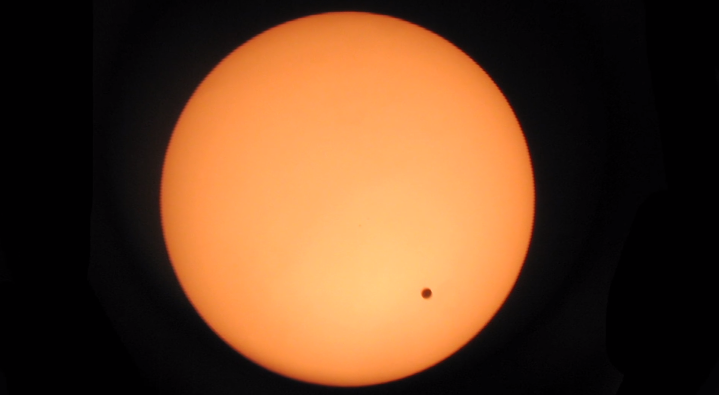
The most recent transit of Venus seen from the Earth occurred on June 8th, 2004 and June 5th, 2012. During the last transit, it took Venus 6 hours and 40 minutes to go from one side of the Sun to the other. According to astronomers, there will not be any transits of Venus until December 2117!
Transits of Mercury, however, are much more frequent than those of Venus. They happen at a rate of 13 transits every century. The most recent transit of Mercury occurred on November 11, 2019, and was preceded by three other transits. The next transit is predicted to take place on November 13, 2032.
Mercury and Venus themselves cannot experience eclipses either because they do not have any moons.
Outermost planet eclipse
Mars happens to have two moons, Phobos and Deimos. But they look more like asteroids than moons for they have quite irregular shapes. They are also incredibly small compared to the Earth’s moon.
Phobos is only 1548.3 km2 in surface area and Deimos’s area is 495.1548 km2 while the Moon’s area is 37.94 million km2! Because of their tiny sizes, Mars cannot experience total solar eclipses since its moons will never be able to totally cover the Sun’s disk.
They are just capable of obscuring just a small area of it. That is why some people like to refer to such events as transits and not eclipses.
Interestingly, Nasa’s Perseverance Rover, which successfully landed on Mars on February 18th, 2021, recorded a stunning solar eclipse on the red planet. It took place on April 21st, 2022 and was caused by Mars’s largest moon Phobos.

Speaking of ‘lunar’ eclipses caused by Mars, that is when Mars goes between the Sun and its moons, they are very common. Hundreds of them happen every year. Since Mars is a lot bigger than its moons, it can completely obscure them.
On rare occasions, Deimos, the small Martian moon, experiences eclipses caused by its big brother Phobos.
The four outermost planets of the Solar System, Jupiter, Saturn, Uranus, and Neptune have large moons. But again, the possibility of having solar eclipses is dependent on the apparent sizes of these moons relative to the Sun. If they look bigger than the Sun, the planet gets solar eclipse. If they are smaller, it is a transit.
Jupiter, for instance, has 53 named moons. Only five of them, Amalthea, Io, Europa, Ganymede and Callisto—all referred to as the Galilean moons—can cause total solar eclipses on the giant planet. The remaining 48 moons are too small and too far from the Sun to completely or even partially obscure it. As a result, they only make transits.
Similarly, seven out of Saturn’s 82 moons enable total solar eclipses on the planet.
Eclipses in old civilisations
Since eclipses are so visible that they cannot go unobserved, many different ancient civilisations recorded eclipses. The oldest of such recordings was found in Ireland carved on rocks. It documented an eclipse that is believed to have happened on November 30, 3340 B.C.E.
More and more records were made by many other civilisations. Such exceptional events were recorded; however, the people of the past did not know why eclipses took place despite the scientific development they had.
Little did they know, our ancestors seem to have been quite sceptical of eclipses. Since they are extraordinary events, our ancestors tended to have dark, petrified connotations about them.
Such dark connotations did apply more to solar eclipses than to lunar eclipses. In fact, the disappearance of the Sun during the day is quite frightening. So it makes perfect sense to think of it as a disastrous event more than a regular astronomical one.
Although the Chinese could record solar eclipses as far back as 4000 years ago, they lacked a scientific explanation for the temporal disappearance of the Sun. So they thought a sky dragon ate it.
To help save the Sun from the dragon, the Chinese would hit the drums during the period of the eclipse. When the Moon finally moved away, officially ending the eclipse, the locals thought the Sun was finally freed from the dragon. This convinced them that their defence technique worked. So they repeated it whenever a solar eclipse happened.
The Norse, which you might know more as the Vikings, believed there was a wolf named Fenrir that was hunting the Sun. The eclipsed Sun, therefore, means the wolf was finally able to catch and eat it.
The ancient Inca civilisation of South America used to worship the Sun as a god called Inti. They generally believed that Inti was quite kind-hearted. When a solar eclipse happened, they thought their Sun god must have been extremely displeased and upset. So the Incans would try to tame his anger and rather satisfy him by fasting and offering sacrifices, some of which were human!
Although the ancient Egyptians worshipped the Sun as well, represented as a falcon-headed man called Ra, they left no records of solar eclipses which is quite strange. Many Egyptologists, however, believe that the Egyptians must have observed eclipses but decided not to record them so as not to provoke the god Ra. They may have thought that such an action would lead to quite unpleasant consequences.
In prehistoric West African civilisations, precisely what is now Togo and Benin in Africa, people used to believe that it was human anger and evil that caused the Sun and Moon to fight. Such a fight resulted in the Moon taking over the Sun.
So to help stop the ongoing battle and bring back the Sun, leaders urged the people to show peace and come together. That apparently would convince the giant sky objects that everything on Earth was alright and that it was time to sign a peace treaty.
Eclipses continued to propose confusion and evoke imaginary explanations and Sun-liberating practices for centuries and centuries. It was not until the seventeenth century when German Astronomer Johannes Kepler understood and gave a scientific explanation for why solar and lunar eclipses happened.
A Pause at the Moon
Before we get into more detail about solar and lunar eclipses, we need to stop for a minute at the Moon and understand some facts about it.
If you look at the Moon in the sky twice that are a few days apart, you will find that it changes shape. On one day, the Moon can be fully lit. You can see it as a large white greyish circle. On other days, it is just half the Moon that is lit. Sometimes the Moon does not appear in the sky at all. So why does this happen? What makes the Moon change shape like that?
Well, the Moon does not actually change shape. Even when we see only half of it, the entire Moon is still revolving in our sky. The truth is, we only see the part that is lit and the rest of the Moon is dark.
Unlike the Sun, the Moon does not produce its own light, because it is not a star. When sunlight falls on it, the Moon reflects it on the Earth and therefore we see it.
The Moon completes one cycle around the Earth in 29.5 days. At the beginning of this cycle, the Moon is in between the Sun and the Earth, tilted 5° to the Earth’s orbit. So when sunlight falls on it, it reflects back to space.
The Earth does not receive any of that reflected light because it is right behind the Moon. Therefore, the Moon does not appear lit in our sky. That is why we think the Moon is not there but it is. It is just that the side that is facing us is darkened. On the other hand, the Moon’s fully lit side is facing the Sun. This is the very first phase of the Moon’s cycle. It is called the New Moon.
As the Moon moves around the Earth, it creates a reflection angle and we start to see small lit parts of it. These parts grow bigger and bigger until we see the Moon fully lit.
This happens when the Moon is behind the Earth, again tilted 5° at the Earth’s orbit. The Moon reflects all the sunlight it receives to the Earth. As a result, we see it as a large bright circle in the sky. This phase is called the Full Moon. It marks half the moon cycle.

During the Moon’s journey from New Moon to Full Moon, it goes through three phases called Waxing Crescent, First Quarter, and Waxing Gibbous. In these phases, the lit part of the Moon gets gradually bigger.
After the Full Moon, the fully lit circle begins to shrink, going through the same phases again but inverted: Waning Gibbous, Third Quarter, and Waning Crescent. Then a new cycle starts with a New Moon.
Solar eclipses
A solar eclipse occurs when the Moon becomes almost or perfectly aligned with the Earth. There are three different types of the solar eclipse. The first is a total solar eclipse. It happens when the Moon, Earth, and Sun exactly line up. In this case, the Moon is very close to the Earth that it appears approximately the same size as the Sun.
If the Moon is farther away from the Earth and looks smaller than the Sun but is still exactly aligned with both, we get an annular eclipse.
Since this perfect alignment is quite rare, total and annular solar eclipses are not that common. We get only one total solar eclipse roughly every 18 months and one annular eclipse every one or two years. What is more common is the partial solar eclipse.
Partial solar eclipses are usually associated with both total and annular solar eclipses. That said, partial eclipses can still happen on their own. This is when the Moon is not exactly aligned with the Earth. It is slightly tilted by a degree that is less than 5° and more than 0°. That makes the Moon blocks a part of the Sun but not all of it. Partial solar eclipses happen about twice a year.
Since solar eclipses are caused by the Moon casting a shadow on the Earth, we need to understand how this shadow works to fully grasp the mechanism of solar eclipses.
The shadows of the Moon
Do you remember the very first phase of the Moon cycle? Yes, that is the New Moon.
A solar eclipse happens during a New Moon, which is technically dark and invisible in the sky. When the New Moon is perfectly aligned with the Earth, it casts a long shadow on the Earth.
This shadow is actually two shadows, one inside the other. They look like two inverted cones. The small shadow is the narrowest and the darkest of both with its apex being on the Earth. This very dark shadow is called the umbra which in Latin means shadow.
The bigger shadow is an inverted cone whose apex is the Moon and base is on the Earth. That means this shadow covers a larger area on the Earth. But it is not as dark. Just exactly like a torch lights a larger area on the wall the farther it is pointed at it, which makes the light get less and less bright. This wider shadow is called the penumbra. Pen is a Latin prefix that means almost. So penumbra means almost a shadow.
Total solar eclipse
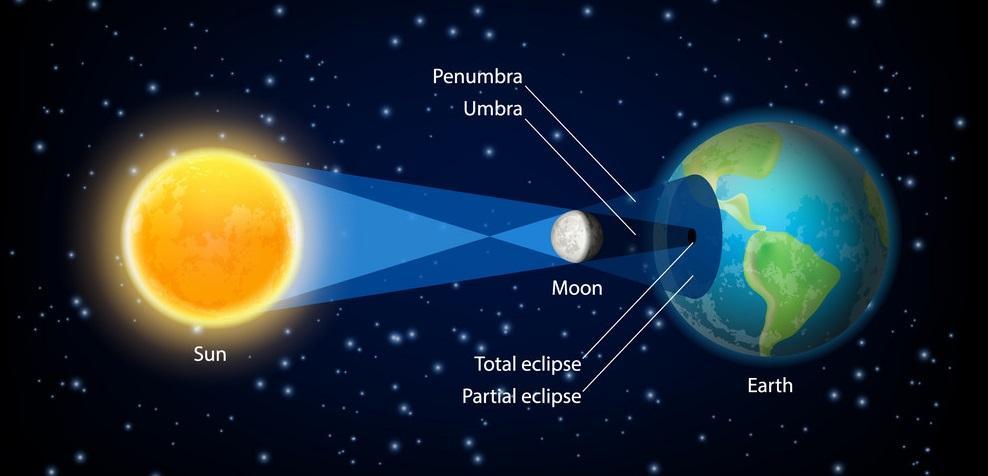
People who happen to be in the umbra region on Earth see a total eclipse of the Sun. The Moon completely covers the Sun’s disk, casting a dark shadow on that area. The umbra is typically about 100–160 km wide.
On the other hand, people who are outside the umbra but are in the penumbra region only see a partial eclipse of the Sun. Here, the Moon only covers a part of the Sun and casts a less dark shadow on the Earth. As we have just learned, the penumbra is much wider than the umbra. It usually has a diameter of at least 6400 km.
People who are neither in the umbra nor the penumbra do not actually view any change. The Sun still appears bright in the sky.
That is to say, a total solar eclipse is only viewed from a small area on the Earth. Interestingly, that very same area does not witness another total solar eclipse until around 360 to 410 years have passed.
That means, people who are lucky enough to view a total eclipse of the Sun from their hometown will not view another one from the same place, even if they live for a century!
Total solar eclipses are not like ‘now you see it now you don’t’. But they rather occur gradually. If you happen to be in the umbra region during a total solar eclipse, you will see the Moon, which in this case will just look like a dark circle, slowly moving in front of the Sun’s disk. At this stage, you will see a small dip in the Sun’s edge. This is when the penumbra sweeps over and the people in that region start to witness a partial eclipse of the Sun.
Then the Moon moves, the dip grows into a bite and we see a thick crescent of the Sun. The Moon moves again and the Sun becomes a thin crescent. When the Sun’s crescent is the thinnest, the umbra begins and starts to darken a small area on the Earth.
Baily beads and the diamond ring
But the Moon is not smoothly round. It is full of craters and depressions. So when it attempts to cover the Sun, these craters allow some beams of sunlight to shine, creating bright patches around the darkened Sun. These patches were called Baily’s beads. They refer to British Astronomer Francis Baily who was the first to describe them in the early 19th-century.
When there is only one beam of light left, it shines so brightly like a diamond on the dark ring of the Moon. This phenomenon was called the diamond ring effect. This effect usually occurs right before the dark Moon’s disk completely covers the Sun and once it starts to move away from it.
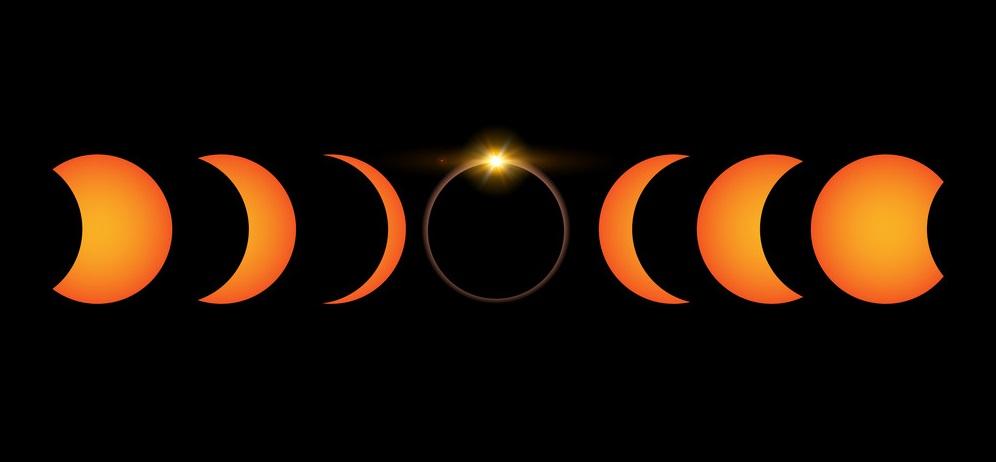
Although the Moon does completely cover the Sun’s disk, it is not like they both disappear. We still see an aura around the dark Moon’s disk; a crown of glowing light. This is known as the Sun’s corona which is actually the Sun’s atmosphere. It is an extremely thin layer of gas that extends for millions of kilometres in outer space.
Usually, this corona is very faint and therefore not seen during daylight due to the Sun’s intense brightness. But during a total solar eclipse, the Sun’s bright lighting disk is obscured so we can see the stunning corona of the Sun.
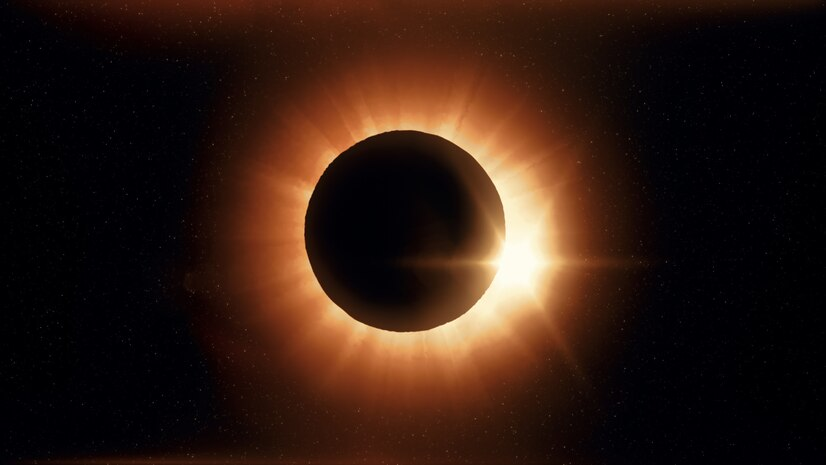
Totality
The Moon entirely covering the Sun is referred to as totality. During totality, it gets completely dark in the umbra region on the Earth, just like night. The air gets cooler. Birds go back to their nests. Stars are also visible in the sky since the bright sunlight that is used to diminishing them is temporarily turned off.
Interestingly, this is the only occasion when we can see stars while the Sun is out there.
Totality, and therefore the umbra, only lasts for a period of 1 second to 7.5 minutes but never longer than eight minutes. The duration of totality depends on different factors. One of them is the distances between the Moon, Sun, and Earth which change their apparent sizes in the sky. In addition, the Sun as well as where the midpoint of the eclipse is relative to the Earth also influence how long totality lasts.
The path of totality
Although the Moon does entirely cover the Sun for a few minutes, it is not stationary during totality. It still moves. This lunar movement as well as the Earth’s rotation, which both happen to be in the same direction from west to east, make the umbra move so rapidly on Earth, also from west to east, creating a track known as the path of totality,
As totality has a different duration each time there is a total solar eclipse, the path of totality also has a different distance and width. The width of the path of totality mainly depends on the apparent diameters of the Earth and the Moon during the total eclipse. These diameters change based on the Moon’s and Earth’s distances from each other and from the Sun.
Wait a minute! Does that propose that the Moon is sometimes closer to the Earth than it is at other times? Well, that is correct. The change in the Moon’s distance from the Earth is attributed to the elliptical orbit of the Moon.
On average, the path of totality is 160 km wide and 16,000 kilometres long. If the Moon happens to be very close to the Earth during a total solar eclipse, totality lasts for over seven minutes and the path can be up to 267 km wide and so incredibly long.
The path of totality explains how parts of many different countries can witness a total solar eclipse. For instance, the longest totality of the 21st-century so far occurred during the solar eclipse of July 22, 2009. It lasted 6 minutes and 39 seconds! The path of totality crossed parts of many Asian countries including India, Nepal, Bangladesh, Bhutan, Myanmar, China as well as the Pacific Ocean.
On the other hand, the shortest totality of the 21st-century up until 2022 was that of the solar eclipse of November 23rd, 2003. It lasted for only 1 minute and 57 seconds. Unfortunately, almost no one could view such a total eclipse for its path of totality passed through east Antarctica, the frozen continent at the south of the globe.
Once totality ends, the Moon starts to move away from the Sun. Though the umbra has already ended, the penumbra, and therefore the partial solar eclipse, is still there and lasts for longer than the umbra. The Sun inversely goes through the same phases, shrinking the penumbra. When the Moon finally and completely moves away from the Sun, the partial solar eclipse ends and the Sun goes back as a bright ball of fire.
Annular and hybrid solar eclipses
If the Moon has a perfectly circular orbit in which it travels around the Earth, it would be at the same distance from the Earth at any given moment.
But the Moon’s orbit is both elliptical and tilted. So the Moon is sometimes closer to the Earth and other times farther. When the Moon is closest to the Earth, it is 363,300 kilometres away from it. This point is called perigee. The farthest point of the Moon from the Earth is called the apogee. It is 406,512 km far from the Earth. This makes the average distance from the Moon to the Earth 384,000 km.
As we have just seen, there is a total solar eclipse when the Moon is closer to the perigee.
But when the Moon is closer to or at the apogee, meaning it is farther away from the Earth, it looks smaller in size than the Sun. If that smaller-than-the-sun Moon gets exactly aligned with the Earth, we get an annular eclipse.
In an annular eclipse, the Moon does not entirely hide the Sun’s face. It leaves out a beautiful thin ring of light around its dark disk. That is why such an eclipse is called annular, referring to the ring shape annulus.
During an annular solar eclipse, the Moon also casts a shadow on the Earth. But this shadow is yet quite different.
We have studied earlier in the case of the total solar eclipse that the Moon’s shadow has two parts: the darker, smaller one named umbra and the lighter, wider one called the penumbra. In the case of the annular eclipse, the Moon’s shadow has three parts; the umbra, penumbra, and antumbra. Ant- is a prefix that means against or opposite. In other words, the antumbra is opposite to the umbra.
During an annular solar eclipse, the umbra does not cast on the Earth but the penumbra and antumbra do. The antumbra region on the Earth is then the area from which people can view the annular eclipse and see that ring of light.
At the centre of the antumbra, the ring looks perfect. In other areas inside it, the Moon does not look perfectly centred on the Sun, making the ring look wider in some areas and narrower in others.
At the very edge of the antumbra, people only see a broken ring or the Bailey beads which we explained earlier. People outside of the antumbra but inside the penumbra can only view a partial eclipse of the Sun. In areas where there are no shadows, viewers see the normal shiny face of the Sun.
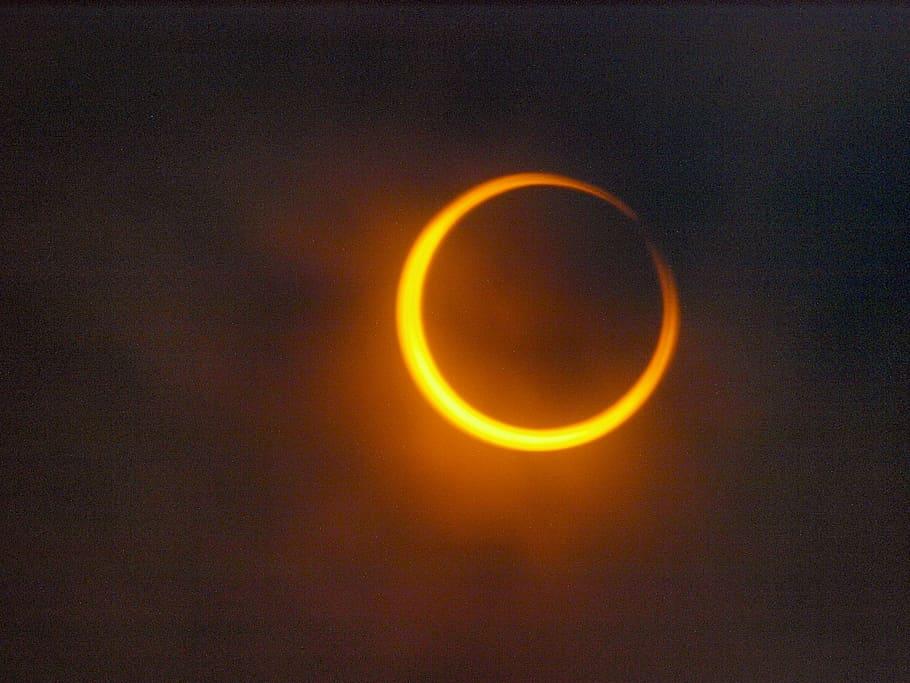
And just like totality, this ring of light stays apparent in the sky for a period called annurality. Annuarlity can last from a second to a maximum of 12.5 minutes. Due to the movement of the Moon and the Earth, a path of annularity is associated with the annual solar eclipse. Typically, the path of annularity has a width of 100 km or even more.
So all in all, the annular eclipse is just like the total solar eclipse except that the Moon does not entirely cover the Sun’s face. As the Moon starts to approach the Sun, the penumbra shadow is cast on the Earth and a partial solar eclipse starts.
Then the Moon covers more and more parts of the Sun until it gets right in the centre of it leaving behind the ring of light. This is when annurality officially begins.
After some time that gets no longer than 12.5 minutes, annularity ends. The antumbra disappears, and the Moon starts to pull away from the Sun while the partial eclipse is still on. Once the Moon gets completely off the Sun, the annular eclipse ends and everything goes back to normal.
Hybrid solar eclipses are a mix of an annular eclipse and a total eclipse. That surely does not mean they both happen at the same time. It only means that a hybrid eclipse is seen as a total eclipse in certain areas on the Earth and annular in other areas.
Hybrid eclipses are quite rare.
Partial solar eclipses
We have just learned that total and annular solar eclipses are always accompanied by partial eclipses which cast the penumbral shadow on the Earth. Partial eclipses can also happen independently from those two types of eclipse.
That is when the Moon passes between the Sun and the Earth but does not line up perfectly with them. This results in the Moon casting the outer shadow only, the penumbra, on the Earth and partially obscuring the Sun.
Sometimes, the Moon covers a small part of the Sun, looking as if it had a bite of it. Other times, the Moon obscures a large section of the Sun.
Partial solar eclipses are more common than total solar eclipses. They happen at least twice a year. In 2011 for instance, there had been four partial solar eclipses.
Another point that is quite distinct about partial solar eclipses is that they are more widely viewed than total solar eclipses. Thanks to the large penumbra, more and more regions of the world can witness partial solar eclipses.
There are only two solar eclipses in 2022 and both of them are partial. The first one occurred on April 30, 2022 and was viewed in Southeast Pacific and South America. The second and last partial solar eclipse is happening on October 25, 2022. Lucky people who live in Europe, northeast Africa, the Middle East, and West Asia will be able to view this phenomenal event while the rest of the world will watch it live on YouTube.
Far future solar eclipses
The Moon happens to be going farther away from the Earth every year. More precisely, the Moon’s orbit gets 3.8 cm farther from the Earth. This mainly is caused by the Moon itself. Here is how.
The Moon exerts a gravitational pull on Earth creating a tidal force. This tidal force causes the water level to increase whenever the Moon is the closest to the Earth. Think of it as if the Moon is pulling the water towards it. This is also described as a tidal bulge.
But the Earth is rotating faster than the Moon so the tidal bulge, as part of the Earth, is technically moving faster than and therefore ahead of the Moon. The tidal bulge then feeds some of its movement energy to the Moon, causing the latter to push away from the Earth into an outer orbit. Every year, the Moon goes farther from the Earth by 3.8 cm.
While this might sound small, its effect, just like that of global warming, is huge in the long run. The Moon going farther away from the Earth translates to it appearing smaller than the Sun in the sky.
At some moment in the far future, the Moon will not be able to entirely block the Sun. As a result, no total eclipses will occur. If our planet is to continue to exist, scientists estimate this no-total-eclipse event to hit roughly between 650 million and 1.4 billion years to come.
One thing to deduct from the fact that the Moon is currently getting farther from us is that in the past, like billions of years ago, the Moon was much much closer to the Earth. That means, only total and partial eclipses used to happen while there were no annual eclipses.
Viewing a solar eclipse
Looking directly at the uneclipsed Sun is fairly dangerous as well as painful. Such exposure to sunlight can damage and sometimes even destroy the cells in the back of the eyes. These cells, called retinas, are in charge of transmitting the pictures we see to the brain. This may also lead to complete blindness.
That said, it is not recommended and rather highly serious to view a solar eclipse with naked eyes. I know you must be wondering why. If the Sun is completely hidden during a total solar eclipse, what damage could this dark Sun do to the eyes anyway?
Well, you are right. If the Sun is hidden, it does no damage to the eyes. However, the damage happens right after totality ends, at that stage of the total solar eclipse when the Moon starts to pull away from the Sun.
During totality, the pupils of the eyes dilate to allow more light in. But when the Moon starts to move away, sunlight flashes suddenly and intensely that it can damage the eye retinas.
Total solar eclipses are a spectacular event to witness though. That is why one has to take extreme precautions to have a good eclipse-watching experience. People should use proper eye protection. This is a kind of special solar eclipse glasses that use solar filters. These filters block most of the sunlight which can damage the eyes.
Such solar eclipse glasses are typically sold in department stores, electronic stores, or even on Amazon.
It is also highly recommended that people buy approved filters and not rely on DIY protections that others share on the Internet such as using old camera negatives or radiographic films. These do not block infrared or ultraviolet radiation as perfectly. Much of this radiation can still reach the eyes and therefore damage them.
Unfortunately, there were not nor will be any total solar eclipses in 2022. The very next total solar eclipse is expected to occur on April 8th, 2024. Its path of totality will cross Mexico, central and northeastern United States, and East Canada while other places in North and Central Americas will view a partial solar eclipse.
Lunar eclipses
Do you remember the two Moon phases we explained earlier? At the beginning of the moon cycle, the New Moon looks utterly dark in the sky and this is when a solar eclipse happens. On the other hand, the Full Moon phase is when the moon is fully lit and occurs in the middle of the moon cycle. This is the phase when a lunar eclipse happens.
A lunar eclipse occurs when the Moon aligns with the Earth which gets in between it and the Sun. In that case, the Earth casts a shadow on the Moon, causing it to be totally or partially eclipsed.
We do not get to a lunar eclipse every Full Moon for the same reason solar eclipses do not always happen at every New Moon: the Moon’s tilt. Such a tilt makes it miss the Earth’s shadow. So it receives sunlight, reflects it to the Earth, and appears brightly lit in our night sky.
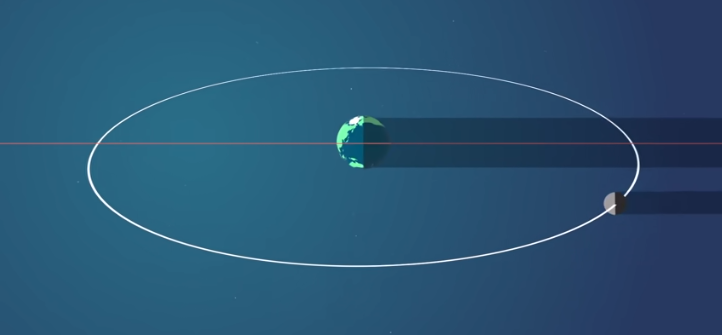
Just like solar eclipses, lunar eclipses happen at least twice and at most five times a year. In the 20-the century, a total of 229 lunar eclipses occurred with the longest of them lasting for 3 hours and 24 minutes.
Similarly, the 21st-century is expected to witness 228 lunar eclipses, 51 of which already occurred by June 2022. The most recent lunar eclipse occurred on May 16th, 2022 and the forthcoming one will be on November 8th, 2022.
Types of lunar eclipses
When the Earth perfectly aligns with the Sun, it blocks sunlight and casts a shadow. Just like we studied before with the Moon, the Earth’s shadow has two different areas in the darkness level.
The smaller area is the darkest and is called the umbra. The wider area is the lightest and is referred to as the penumbra. When the Moon enters either the umbra or penumbra, lunar eclipses happen.
There are three types of lunar eclipse: total, partial, and penumbral.
A penumbral lunar eclipse happens when the Moon slightly but not perfectly lines up with the Earth. It misses the Earth’s umbra but enters its penumbra. The light shadow of the penumbra makes the Moon look dim in the sky with a little darker grey colour. Sometimes penumbral lunar eclipses happen but people do not realise them.
But the Earth’s umbra is already too wide; about 9000 km. This makes it so incredibly hard for the Moon to miss it. That is why penumbral lunar eclipses are quite rare. When they do happen, the Moon gets too close to the umbra, resulting in this side of it looking darker than the rest of the dim Moon.
The more common penumbral lunar eclipses are those that accompany partial and total lunar eclipses.
A partial lunar eclipse happens when the Moon is also imperfectly lining up with the Earth. The difference, in this case, is that the tilt of the Moon allows it to partially enter the Earth’s umbra. As a result, the Moon looks as if the Earth has taken a bite of it.
But we know that entering the umbra is preceded by entering the penumbra. That means a partial lunar eclipse comprises a penumbral eclipse.
Before the eclipse starts, the Moon is happy and bright. Then it enters the penumbra and gradually gets dim. After that, it partially enters the umbra. So a part of it is invisible and the rest of it is still dim.
The partial eclipse lasts for some time then the Moon starts to pull away from the umbra. It gradually gets back to its fully rounded shape but is still a little dark. This is because the Moon is still in the penumbra. Therefore, the penumbral eclipse is still ongoing. Then the Moon starts to leave the penumbra and we see it getting as bright as usual.
A total lunar eclipse happens when the Moon is perfectly aligned with the Earth, making it totally enter the Earth’s umbra. And just like with the partial eclipse, a total lunar eclipse is also accompanied by a penumbral eclipse.
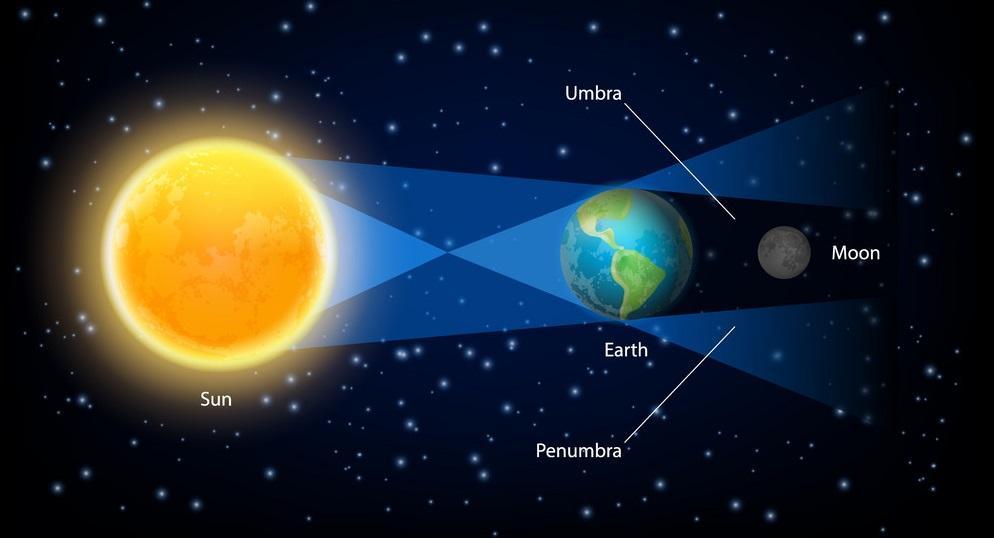
As the Moon gradually falls into the shadow, it first gets dim. Once it enters the umbra, it is slowly obscured. The moment the Moon is completely in the umbra looking almost completely too dark to be invisible, it turns red.
Lunar totality lasts for some time then the Moon starts to move away from the Earth’s umbra and penumbra, gradually getting back to its fully lit state.
Redness of the Moon
Here so many questions spontaneously pop up. Why does the Moon not get totally dark when eclipsed just like the Sun gets fully dark in a total solar eclipse? And why does it turn red in particular? Why not blue or green, for instance?
The answer to all these questions is simple: Earth’s atmosphere.
To understand how the Moon turns red, we just need to explore a simple concept of physics: refraction.
White light is the colourless daylight. It comprises seven different lightwaves: violet, indigo, blue, green, yellow, orange, and red.
When the white light travels from one medium to another, say from air to water and then to air again, it gets bent. This bending is called refraction. Refraction can be strong or weak depending on the wavelength of the light.
Violet, blue, and green have short wavelengths with violet having the shortest. On the other hand, yellow, orange, and red have the longest wavelengths and the red light has the longest. So when light is refracted by a medium, each coloured light is bent differently and therefore we can see them.

We are all familiar with this through the rainbow phenomenon that sometimes happens after the rain. When it stops raining, there are still some water droplets in the air. When direct sunlight travels through these water droplets, it gets refracted resulting in the beautiful arc of rainbow.
Now let’s get back to our topic.
As the Earth is totally obscuring the Moon, there is still sunlight that enters the Earth’s atmosphere. Remember what the atmosphere is made of? Yes, gas and dust. These particles refract the light waves. The blue light is refracted more strongly so it gets scattered out in all directions. This is why the sky looks blue.
On the other hand, the red light is bent more weakly inward towards the Moon during a full lunar eclipse. As a result, the Moon looks red.
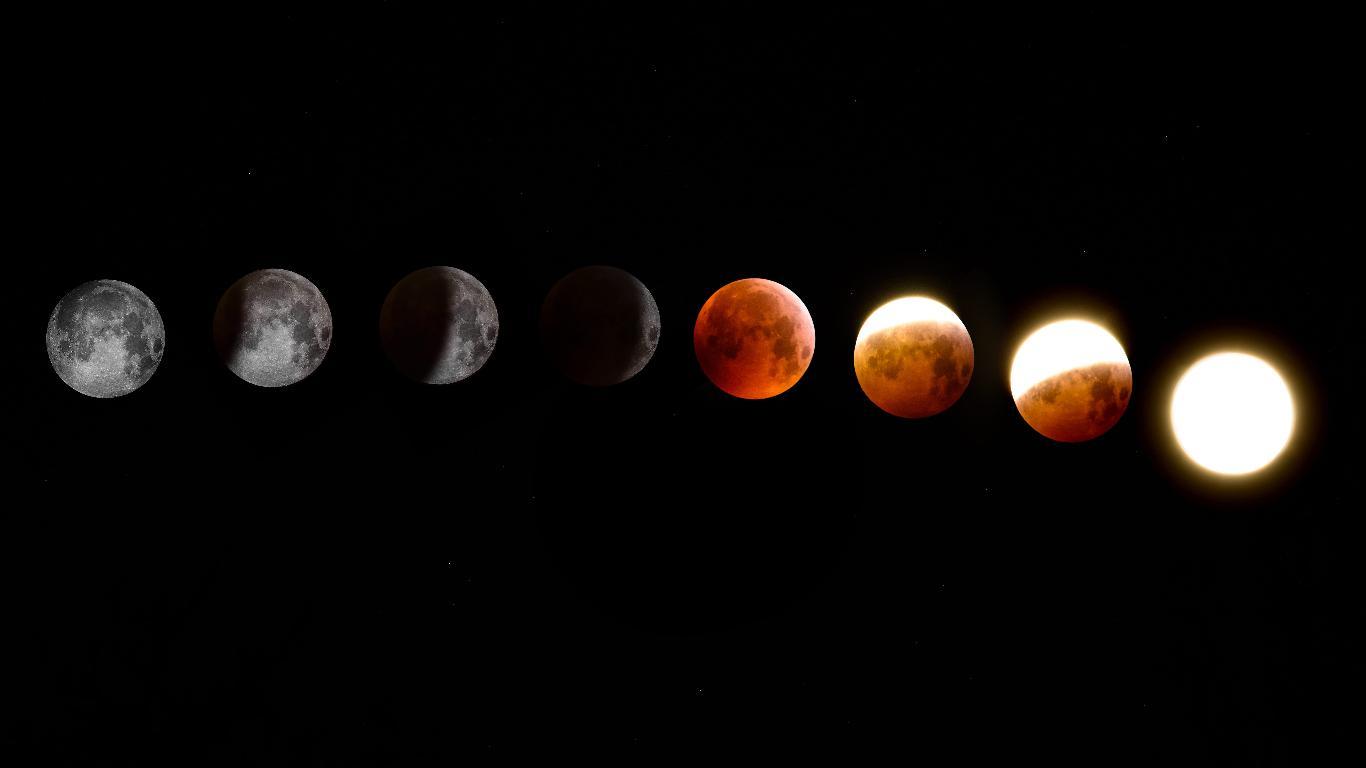
If the Earth had no atmosphere, the Moon would be entirely darkened during a total lunar eclipse.
We must also mention here that the same concept that turns the Moon red during a total lunar eclipse is what makes the horizon look red during either sunrise or sunset.
Lunar eclipse duration
The lunar eclipse duration, from start to end, mainly depends on the Moon’s orbit position relative to the Earth.
If the Moon is farther from the Earth and closer to the apogee, its speed is almost the slowest. That is because the gravitational pull of the Earth is a little weaker. Therefore, the eclipse duration is long. The opposite is also true.
If the Moon is closer to the Earth, the latter exerts more gravitational pull on it, making it move faster. So if the Moon looks relatively big in the sky during a total lunar eclipse, it will probably not last as long.
Generally, the full duration of a total lunar eclipse can be as long as four hours. Speaking of totality alone, it can range between one second and 107 minutes.
Viewing a lunar eclipse
Unlike solar eclipses that are exclusive to the regions that lie inside the Moon’s umbra and penumbra, anyone in the nighttime half of the Earth can view a lunar eclipse. Also it is safe to look directly at the lunar eclipse for it does no damage to the eyes.
Conclusion
Eclipses are stunning, miraculous, natural phenomena. Witnessing an eclipse, especially a total solar one, is a lifetime experience that one should never miss if they get to see it.
In this article, we explored what it takes to have an eclipse as well as how eclipses work. We learned that any two space objects that are close enough and more likely to line up with each other and the Sun can cause eclipses.
When an object gets between the Sun and another object, it casts a shadow on the latter. Such a shadow has two areas the umbra and the penumbra. The umbra is darker and narrower and the penumbra is less dark and wider.
Solar eclipses occur when the Sun is obscured by the Moon while lunar eclipses happen when the Moon is obscured by the Earth. In a total solar eclipse, the Sun completely disappears leaving only an aura of light around the dark disk of the Moon. On the other hand, the Moon is still visible in a total lunar eclipse though it looks red.
At least four and up to ten solar and lunar eclipses occur each year. Usually, they are announced on news websites and networks before they take place. So if you happen to be in a region where a solar or lunar eclipse can be viewed, do not miss this extraordinary experience. Just make sure you use proper eye protection in the case of solar eclipses.


Leave a Reply